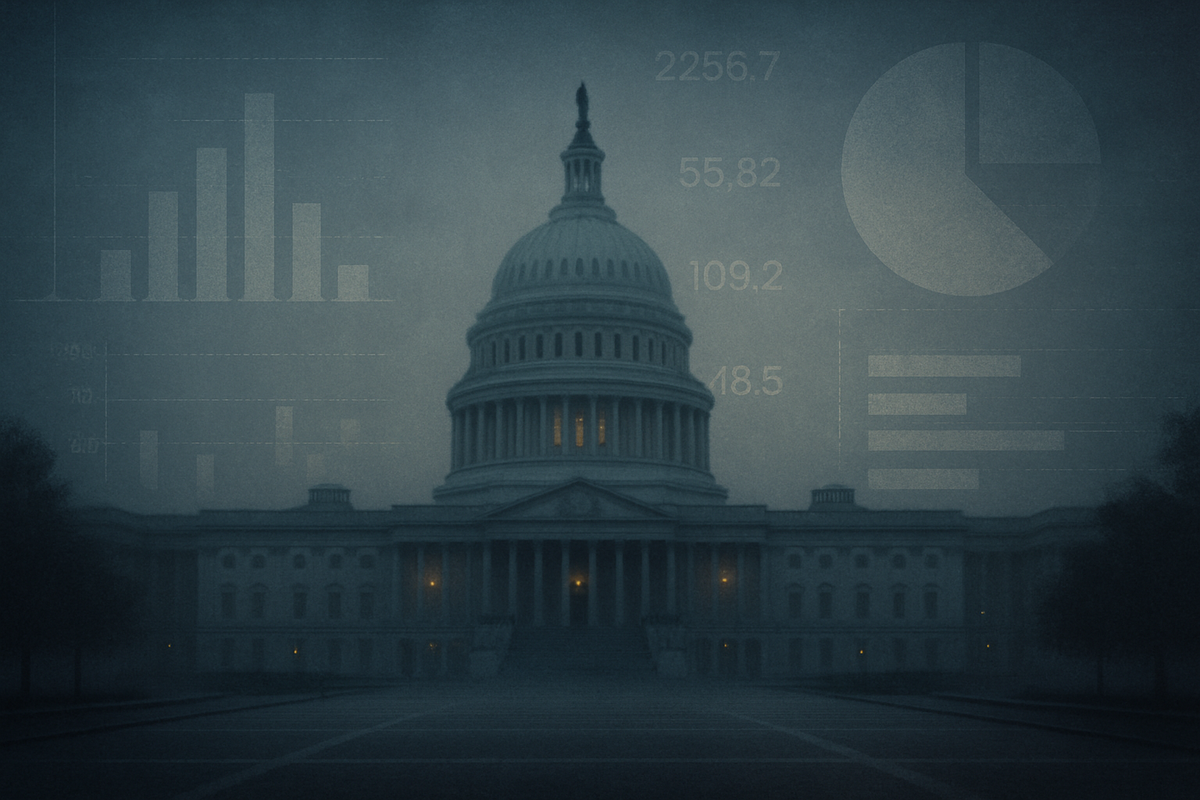
The ongoing government shutdown has plunged financial markets into a state of heightened uncertainty, as the vital flow of economic data—the lifeblood of informed decision-making—grinds to a halt. With key agencies like the Bureau of Labor Statistics (BLS), Bureau of Economic Analysis (BEA), and the Census Bureau ceasing non-essential operations, critical reports on employment, inflation, and GDP are indefinitely postponed. This information vacuum leaves policymakers, businesses, and investors operating in the dark, struggling to accurately assess the health of the U.S. economy and price assets effectively.
Perhaps most critically, this data drought severely complicates the Federal Reserve's dual mandate of maximizing employment and maintaining price stability. Tasked with making crucial monetary policy decisions, including setting interest rates, the Fed relies heavily on timely and accurate economic indicators. Without these essential inputs, the central bank is forced to navigate a "little bit blind," increasing the risk of suboptimal policy choices at a potentially critical juncture for the nation's financial future. The absence of reliable data fuels market volatility, fosters cautious sentiment, and casts a long shadow over the economic outlook.
An Unprecedented Data Vacuum: Echoes of Past Standoffs
The current governmental impasse, while unique in its immediate context, echoes historical battles that have similarly paralyzed federal data collection and dissemination. Past shutdowns have repeatedly demonstrated the profound impact on the nation's economic intelligence. During the 2013 shutdown, which lasted 16 days, the Bureau of Labor Statistics (BLS) and the Bureau of Economic Analysis (BEA) suspended operations, leading to an "unprecedented data vacuum." The crucial September jobs report, weekly unemployment claims, inflation figures, and third-quarter GDP estimates were all delayed. Similarly, the longest shutdown in U.S. history, a 35-day ordeal from late 2018 to early 2019, resulted in a "data drought" with over ten vital releases, including trade, housing, and consumer spending figures, being paused.
These shutdowns arise from fundamental disagreements between the executive and legislative branches over fiscal policy and appropriations. The 2013 shutdown, for instance, stemmed from a congressional deadlock over the Affordable Care Act, while the 2018-2019 shutdown centered on funding for a border wall. Key players consistently include the President, the House of Representatives, and the Senate, each vying for their policy priorities. The Federal Reserve, though independently funded and thus able to continue its operations, finds its ability to conduct data-dependent monetary policy severely hampered, forcing it to rely on less comprehensive private sector indicators and anecdotal evidence.
Initial market reactions to past shutdowns have been mixed. While the 2013 shutdown saw the S&P 500 (SPX) gain 3.1% over its 16-day duration, it still contributed to increased market volatility. The 2018-2019 shutdown initially saw a market dip, followed by a remarkable 10% surge over the five-week period, demonstrating market resilience. However, the CBOE Volatility Index (VIX) typically sees an uptick, reflecting increased investor apprehension. The core issue remains the "data blackout," leaving investors and policymakers "flying blind" and forcing them to assess the economy's trajectory with limited visibility, a scenario that breeds caution and uncertainty.
Corporate Crossroads: Who Wins and Who Loses in the Data Void
The halting of economic data due to the government shutdown creates a stark divide in the corporate landscape, separating those poised to weather the storm from those facing significant headwinds. The absence of crucial reports on employment, inflation, consumer spending, and housing impacts various sectors differently, influencing everything from operational decisions to investment strategies.
Companies and Sectors Most Vulnerable (Potential Losers):
Industries highly sensitive to interest rates and consumer confidence are among the most exposed. The Financial Services sector, particularly mortgage lenders and investment banks, struggles as the Federal Reserve's inability to make informed interest rate decisions creates volatility in bond markets and mortgage rates, making it difficult for lenders to underwrite loans and for investors to price deals. This complicates underwriting and deal pricing for institutions like Rocket Companies (NYSE: RKT) or the mortgage division of Wells Fargo (NYSE: WFC). The Real Estate sector, encompassing residential and commercial developers, brokers, and home improvement retailers, also faces significant challenges. Delayed housing starts, building permits, and a lack of consumer confidence data deter large purchases. Homebuilders such as Lennar (NYSE: LEN) and D.R. Horton (NYSE: DHI), as well as retailers like Home Depot (NYSE: HD) and Lowe's (NYSE: LOW), could see reduced demand.
Discretionary Retail and Hospitality are also heavily dependent on consumer spending and confidence. Without reliable employment and inflation figures, forecasting demand and managing inventory become precarious, especially if furloughs or layoffs reduce consumer purchasing power. Companies like Macy's (NYSE: M) or Starbucks (NASDAQ: SBUX) could experience softer sales. Furthermore, Small and Medium-sized Enterprises (SMEs), often lacking extensive in-house economic research capabilities, are particularly vulnerable as they find it harder to assess market health, impacting hiring and expansion plans. They may also face delays in Small Business Administration (SBA) loan approvals.
Companies and Sectors with Relative Resilience (Potential Winners/Less Affected):
While an overall economic slowdown is rarely beneficial, some companies and sectors are better positioned to navigate the data vacuum. Essential Goods and Services providers, falling under Consumer Staples, Utilities, and certain Healthcare Services, tend to exhibit more stable demand regardless of economic fluctuations. Large grocery chains like Walmart (NYSE: WMT) or Costco (NASDAQ: COST), utility companies such as WEC Energy (NYSE: WEC), and established pharmaceutical giants like Johnson & Johnson (NYSE: JNJ) are examples.
Companies with Robust Internal Data Analytics and Diversified Market Intelligence also gain a relative advantage. Firms that can leverage their own sophisticated data models and alternative private data sources—such as those from financial technology firms like ADP (NASDAQ: ADP) for employment data—are better equipped to make informed decisions than competitors lacking such resources. Major technology companies with extensive data science capabilities, like Microsoft (NASDAQ: MSFT), with its enterprise focus and cloud services, fall into this category. Similarly, companies with Long-Term Contracts or Stable Recurring Revenue Streams, such as those in cloud computing and enterprise software, often have more predictable demand that can cushion them against short-term economic uncertainty.
In essence, the shutdown exacerbates existing vulnerabilities and highlights the importance of data-driven decision-making. Companies that can adapt to the "data blind spot" through internal capabilities, diversified revenue, or essential product offerings will likely fare better than those whose operations are acutely tied to the now-absent federal economic reports.
Broader Implications: Eroding Trust and Reshaping Decision-Making
The current government shutdown, with its immediate impact on economic data, extends far beyond mere delays; it represents a significant disruption to broader industry trends, creates ripple effects throughout the economy, and carries profound regulatory and policy implications, ultimately eroding trust in governmental functionality and data integrity.
In terms of broader industry trends, the "data blind spot" affects virtually every sector reliant on accurate economic information. Financial markets, already prone to volatility, become even more susceptible to sentiment-driven trading as investors "fly blind" without jobs reports, inflation figures, and GDP growth numbers. This uncertainty can lead to deferred capital expenditures and delayed investment decisions across the board. Industries like retail and consumer spending struggle to adjust inventory and marketing strategies without timely data on consumer confidence. Manufacturing and global supply chains face disruptions as regulatory delays, such as customs clearances and food/drug safety inspections, slow commerce and increase costs. The housing and construction sectors are left guessing about market health without crucial data from the Census Bureau. This environment accelerates a trend towards alternative data sources, with economists and investors increasingly turning to private-sector employment surveys, real-time payment data, and AI-driven forecasting to fill the void.
The ripple effects on competitors and partners are substantial. Federal government contractors are among the hardest hit, facing delayed payments, halted projects, and potentially lost wages for employees, directly impacting their revenue and investment plans. Small businesses, often reliant on federal contracts or Small Business Administration (SBA) loan financing, can suffer immensely, as past shutdowns have seen the SBA cease processing new loans. Beyond direct contracts, regulatory delays from furloughed staff can slow global commerce, affecting businesses reliant on U.S. regulatory sign-off for product launches or market access. This can cascade through interconnected global supply chains, affecting international partners and potentially increasing costs and lead times.
From a regulatory and policy perspective, the implications are critical. The Federal Reserve's monetary policy becomes inherently riskier as the central bank is forced to operate without its "gold standard" data. This "flying blind" scenario increases the risk of policy missteps—either tightening too much in a weakening economy or remaining too loose in an inflationary one—and can affect market expectations for future rate adjustments. Other regulatory agencies, such as the Securities and Exchange Commission (SEC) and the Food and Drug Administration (FDA), also operate with minimal staff, slowing down critical approvals for new drugs, environmental permits, Initial Public Offerings (IPOs), and mergers and acquisitions (M&A).
Historically, the U.S. has experienced numerous government shutdowns, with notable instances including the 16-day shutdown in 2013 and the record 35-day shutdown from 2018-2019. While the direct impact on the U.S. stock market has often been surprisingly muted in the short term, with the S&P 500 (SPX) sometimes even showing resilience, the economic costs are real. The 2013 shutdown subtracted an estimated 0.3 percentage points from annual GDP, and the 2018-2019 shutdown cost the economy an estimated $11 billion. More importantly, when a shutdown occurs during a period of heightened economic uncertainty, the data delays become far more critical, obscuring the true state of an economy at a crossroads.
The most profound long-term consequence is the erosion of trust in government functionality and data integrity. Shutdowns undermine public and investor confidence in the government's ability to provide stability and perform its basic functions. This political dysfunction creates fiscal uncertainty, leading investors to question the government's capacity to compromise. When the collection and reporting of economic data are disrupted by political squabbles, the credibility of that data—a cornerstone of informed decision-making—is threatened. This "credibility recession" can raise borrowing costs, trigger capital flight, and fundamentally recalibrate how businesses and investors approach strategic planning, fostering a permanent shift towards a wider array of alternative data sources and a diminished reliance on official government statistics as the sole "gold standard."
The Road Ahead: Navigating the Data Darkness
As the government shutdown persists, delaying the release of critical economic data, the path forward for businesses, policymakers, and investors becomes increasingly fraught with uncertainty. The immediate future promises continued economic drag and heightened market volatility, while the long-term outlook hinges on the duration of the impasse and the ability of various stakeholders to adapt to the "data blackout."
In the short term, each week of continued shutdown is expected to shave approximately 0.1 to 0.2 percentage points off annualized GDP growth. This economic drag stems from reduced government activity, delayed procurement, and a dip in consumer spending as furloughed federal workers face immediate income loss, even if back pay is eventually provided. Financial markets will likely remain volatile, with continued uncertainty potentially leading to modest short-term declines in the dollar index and reduced trading volumes as investors adopt a cautious stance. Regulatory bottlenecks will also intensify, as agencies like the SEC, FDA, and EPA operate with minimal staff, slowing down critical approvals for IPOs, drug trials, environmental permits, and M&A reviews, significantly impacting sectors like biotech, energy, and financial services.
Longer term, the implications could be more severe. While much of the lost economic activity from short shutdowns is often recouped, some losses, particularly in service industries or due to unrecovered GDP, can become permanent. The 2018-2019 shutdown, for instance, resulted in an estimated $3 billion in permanently lost GDP. A prolonged shutdown also risks a reduction in the quality of economic data, making it harder to gauge the economy's true health even after reopening. Repeated or extended disruptions could fundamentally shift long-term investor sentiment, leading to a weaker growth outlook being priced into markets. Unprecedented threats of permanent federal job losses, if actualized, would further undermine the labor market and consumer income.
Businesses are already being compelled to make strategic pivots. Many are diversifying their information sources, reducing dependence on official government data by exploring alternative private-sector data, such as credit card expenditures, payroll reports from companies like ADP (NASDAQ: ADP), and industry-specific surveys. Companies are also investing in proprietary internal metrics and analytical models to maintain market intelligence. Scenario planning and stress testing of revenue and cash flow, especially for firms with significant government exposure, are becoming essential. Furthermore, adjusting contract terms to include data disruption contingencies and prioritizing flexible balance sheets are crucial adaptations.
For the Federal Reserve, the challenge is immense. Without access to official reports on employment and inflation, the Fed is forced to rely more heavily on private sector indicators and anecdotal evidence, which are considered less comprehensive. This significantly increases uncertainty in monetary policy decision-making. If the economy is at an inflection point—such as entering a slowdown or facing accelerating inflation—the "blindness" could lead to delayed or inappropriate policy responses, exacerbating economic problems. Some analysts suggest that in such an environment, the Fed might lean towards more accommodative policies, such as interest rate cuts, especially if private data points to labor market weakness.
Market opportunities, though scarce in such an environment, may emerge for private data providers and analytical firms that can effectively fill the information gap. Conversely, significant challenges include amplified market volatility, higher risk premiums in sensitive sectors, and investment delays due to the obscured economic outlook. The most concerning scenario remains a prolonged shutdown, which could lead to significant disruptions in critical sectors like air travel due to staffing shortages, substantial market corrections, and a sustained weaker growth outlook. The cumulative GDP losses become less likely to be fully recovered, and the risk of economic misjudgment and policy errors by the Federal Reserve looms large.
Conclusion: Navigating the Fog of Uncertainty
The ongoing government shutdown and the consequent halt in crucial economic data releases present a significant, albeit potentially temporary, challenge to the stability and transparency of the U.S. financial landscape. While historical precedents suggest that the broader economic impact of such impasses is often muted and temporary, the current situation underscores the critical role of timely, accurate data in fostering informed decision-making across all sectors.
Key Takeaways: The most immediate and pressing impact is the "data blackout," leaving the Federal Reserve, businesses, and investors "flying blind." Critical reports on employment, inflation, and GDP are indefinitely suspended, creating an information vacuum. Historically, shutdowns have caused a modest drag on GDP, typically 0.1% to 0.2% per week, though much of this is often recouped. Financial markets have, in many past instances, shown resilience, often perceiving these political impasses as temporary disruptions. However, the current discussions around potential permanent federal job cuts introduce a new and potentially more damaging variable not seen in prior shutdowns.
Market Moving Forward: In the immediate term, expect heightened market volatility and increased reliance on alternative, private-sector data sources. The Federal Reserve's ability to make data-dependent monetary policy decisions, particularly on interest rates, will be severely complicated. This uncertainty will fuel speculation and could lead to increased caution among investors. Despite the immediate disruptions, many analysts anticipate that markets will eventually look past the political stalemate, with underlying economic fundamentals reasserting their influence once a resolution is found. Any shutdown-induced market weakness could present selective buying opportunities for long-term investors.
Significance and Lasting Impact: The long-term significance hinges on the shutdown's duration. Short, contained shutdowns generally have minimal lasting economic damage. However, a protracted shutdown, lasting several weeks or more, risks more tangible and potentially irreversible economic costs, including permanent GDP losses in certain sectors. More profoundly, repeated government shutdowns erode confidence in the stability and functionality of U.S. governance, potentially impacting long-term investor sentiment and the perception of data integrity. Should permanent federal layoffs occur, this would mark a significant departure from past scenarios, leading to a more profound and enduring economic drag.
What Investors Should Watch For: In the coming months, investors must closely monitor the shutdown's duration and the specifics of its resolution, particularly regarding any workforce reductions or broader fiscal policy changes. Federal Reserve commentary and actions will be crucial, as officials navigate the data void. The eventual release of delayed economic data will provide a clearer, albeit retrospective, picture of the economy's performance. Consumer and business sentiment surveys will offer real-time gauges of confidence. Investors should also assess sector-specific impacts, especially on government contractors and regulated industries. Finally, while the shutdown commands headlines, maintaining focus on broader market fundamentals like corporate earnings and global economic trends, which historically exert greater influence, remains paramount. Movements in fixed income markets, such as Treasury yields, will also signal shifts in investor risk perception and expectations for future economic growth and inflation.
This content is intended for informational purposes only and is not financial advice





